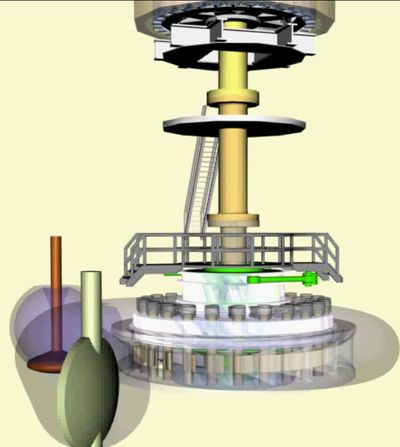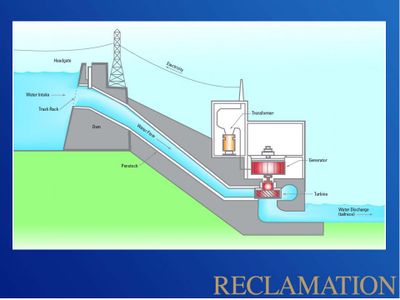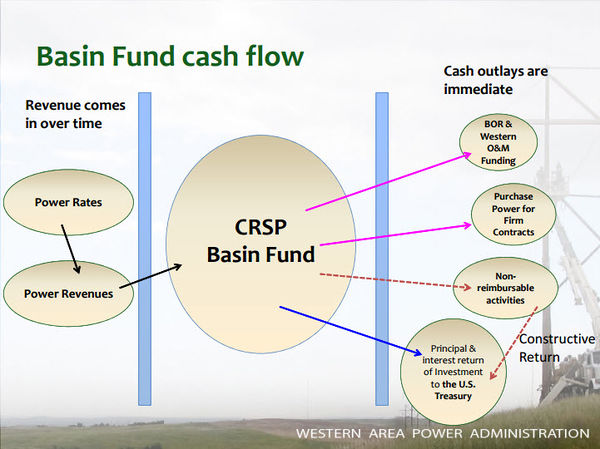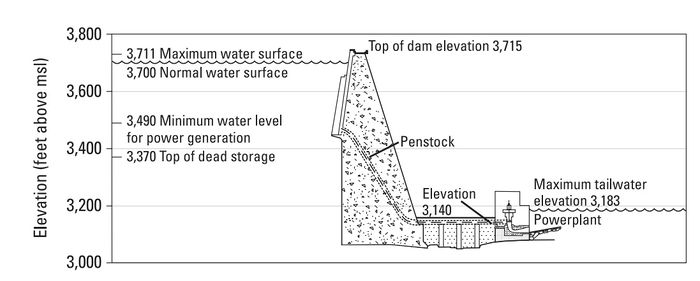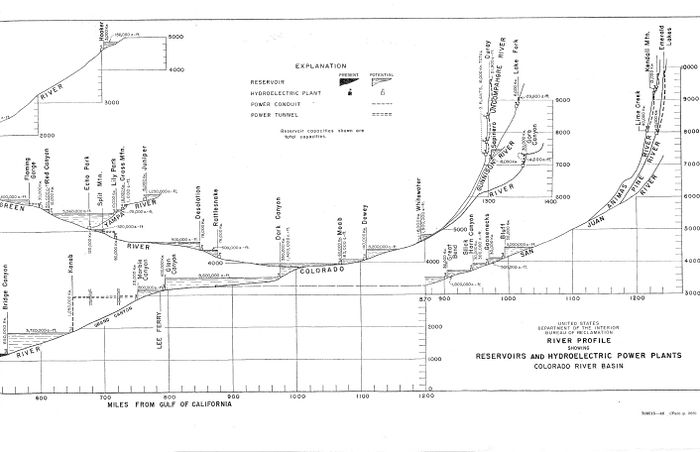Difference between revisions of "HYDROPOWER"
Cellsworth (Talk | contribs) |
Cellsworth (Talk | contribs) |
||
| Line 94: | Line 94: | ||
The approximately $16.5 million per year of power revenues expended for the Glen Canyon Adaptive Management Program, the Upper Colorado River Recovery Implementation Program, and the San Juan Basin Recovery Program are expenses that are not built into the firm power rates. This arrangement benefits the programs in that they do not need to seek annual appropriations from Congress for these funds. However, this does have an impact to Western in times when firming power purchase expenses are high (due to drought or experimentation) because the moneys are transferred to the program and are not available to purchase the power needed to meet contractual requirements. The Basin Fund is managed by Western. Approximately $120 million in revenue is needed each year to fund Reclamation and Western operation and maintenance needs. Western is responsible for transmission and marketing of CRSP power, collecting payment for the power, and transfer of revenues for repayment to the United States Treasury Department. A change in the amount of available capacity or energy could potentially affect the revenue derived from the sale of energy and the contributions to the Basin Fund, or rates charged to power customers. [https://www.usbr.gov/uc/rm/crsp/index.html] | The approximately $16.5 million per year of power revenues expended for the Glen Canyon Adaptive Management Program, the Upper Colorado River Recovery Implementation Program, and the San Juan Basin Recovery Program are expenses that are not built into the firm power rates. This arrangement benefits the programs in that they do not need to seek annual appropriations from Congress for these funds. However, this does have an impact to Western in times when firming power purchase expenses are high (due to drought or experimentation) because the moneys are transferred to the program and are not available to purchase the power needed to meet contractual requirements. The Basin Fund is managed by Western. Approximately $120 million in revenue is needed each year to fund Reclamation and Western operation and maintenance needs. Western is responsible for transmission and marketing of CRSP power, collecting payment for the power, and transfer of revenues for repayment to the United States Treasury Department. A change in the amount of available capacity or energy could potentially affect the revenue derived from the sale of energy and the contributions to the Basin Fund, or rates charged to power customers. [https://www.usbr.gov/uc/rm/crsp/index.html] | ||
| + | |||
| + | |- | ||
| + | ! <h2 style="margin:0; background:#cedff2; font-size:120%; font-weight:bold; border:1px solid #a3b0bf; text-align:left; color:#000; padding:0.2em 0.4em;"> How are the costs associated with experimentation and the environmental programs paid for? </h2> | ||
| + | |- | ||
| + | |style="color:#000;"| | ||
| + | |||
| + | *Costs incurred during experimentation, like funding dedicated to environmental programs, are booked as a non-reimbursable activity. | ||
| + | *This means they can be booked as a constructive return (i.e. in lieu of an actual cash return) to the U.S. Treasury as a payment against the loan that was taken out to construct the CRPS units. | ||
| + | *The amount WAPA returns to the Treasury for the construction of the CRSP units is finite and scheduled. | ||
| + | *As the amount WAPA needs to return to the Treasury gets smaller, the amount of interest incorporated in the return also gets smaller. | ||
| + | *As these amounts gets smaller over time, it reduces the amount WAPA can claim as a non-reimbursable return. | ||
| + | *Over time, this reduces the amount of funding available for non-reimbursable activities like experimentation and environmental programs. | ||
[[File:BasinFund.jpg|center|thumb|600px|http://gcdamp.com/images_gcdamp_com/2/23/Jeka_PPT_Western_CRPS_Aug_2013_AMWG.pdf]] | [[File:BasinFund.jpg|center|thumb|600px|http://gcdamp.com/images_gcdamp_com/2/23/Jeka_PPT_Western_CRPS_Aug_2013_AMWG.pdf]] | ||
|- | |- | ||
| − | ! <h2 style="margin:0; background:#cedff2; font-size:120%; font-weight:bold; border:1px solid #a3b0bf; text-align:left; color:#000; padding:0.2em 0.4em;"> How does | + | ! <h2 style="margin:0; background:#cedff2; font-size:120%; font-weight:bold; border:1px solid #a3b0bf; text-align:left; color:#000; padding:0.2em 0.4em;"> How does operations at Glen Canyon Dam fit into operations with other CRSP hydropower units? </h2> |
|- | |- | ||
|style="color:#000;"| | |style="color:#000;"| | ||
Revision as of 17:11, 25 October 2019
|
|
The Hydropower ResourceGlen Canyon Dam is the second highest (710 feet) concrete-arch dam in the United States, second only to Hoover Dam which stands at 726 feet. The 26.2 million acre-feet of water storage capacity in Lake Powell, created by Glen Canyon Dam, serves as a ‘bank account’ of water that is drawn on in times of drought. This stored water has made it possible to successfully weather extended dry periods by sustaining the needs of cities, industries, and agriculture throughout the West. Hydroelectric power produced by the dam’s eight generators helps meet the electrical needs of the West’s rapidly growing population. With a total capacity of 1,320 megawatts, Glen Canyon Powerplant produces around five billion kilowatt-hours of hydroelectric power annually which is distributed by the Western Area Power Administration to Wyoming, Utah, Colorado, New Mexico, Arizona, Nevada, and Nebraska. In addition, revenues from production of hydropower help fund many important environmental programs associated with Glen and Grand canyons. The designation of Glen Canyon National Recreation Area in 1972, underscores the value and importance of the recreation benefits associated with Lake Powell and the Colorado River downstream of the dam. The GCNRA is managed by the National Park Service. Glen Canyon Dam is the key water storage unit of the Colorado River Storage Project, one of the most complex and extensive river resource developments in the world. Without it, development of the Upper Colorado River Basin states’ portion of the Colorado River would not have been possible. [1] LTEMP Resource Goal for the Hydropower ResourceMaintain or increase Glen Canyon Dam electric energy generation, load following capability, and ramp rate capability, and minimize emissions and costs to the greatest extent practicable, consistent with improvement and long-term sustainability of downstream resources. Desired Future Condition for the Hydropower Resource• Glen Canyon Dam capacity and energy generation is maintained and increased, so as to produce the greatest practicable amount of power and energy, consistent with the other DFCs. |
| --- |
Hydropower - Online Training |
--- |
|---|
|
|
